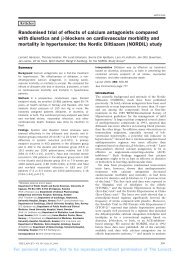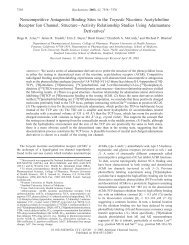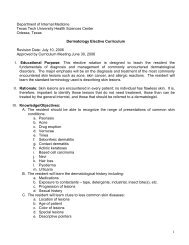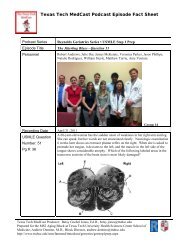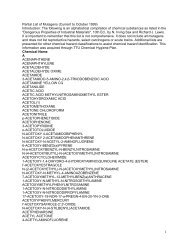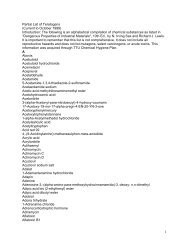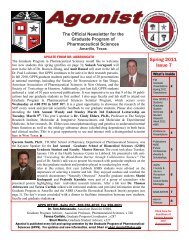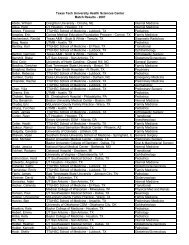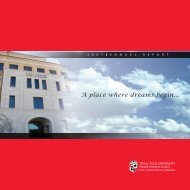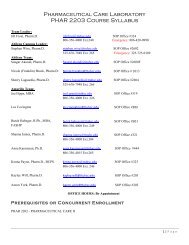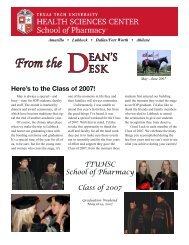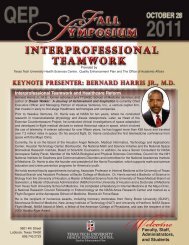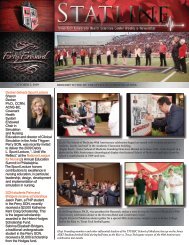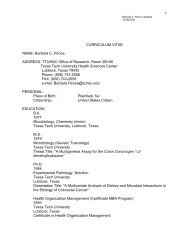Fall 2011 - Texas Tech University Health Sciences Center
Fall 2011 - Texas Tech University Health Sciences Center
Fall 2011 - Texas Tech University Health Sciences Center
You also want an ePaper? Increase the reach of your titles
YUMPU automatically turns print PDFs into web optimized ePapers that Google loves.
<strong>Fall</strong> <strong>2011</strong> Vol. 9/No.4<br />
The<br />
Rural and<br />
Community<br />
<strong>Health</strong><br />
Messenger<br />
F. Marie Hall Institute Celebrates the<br />
Inaugural National Rural <strong>Health</strong> Day<br />
On Thursday, November 17 th ,<br />
<strong>2011</strong> the F. Marie Hall Institute<br />
for Rural and Community<br />
<strong>Health</strong>, along with the National<br />
Organization of State Offices of Rural<br />
<strong>Health</strong> (NOSORH), and other state/<br />
national rural stakeholders, celebrated<br />
the first-ever National Rural<br />
<strong>Health</strong> Day. National Rural <strong>Health</strong><br />
Day was created as a way to celebrate<br />
the innovativeness and determination<br />
of rural communities across America,<br />
while promoting awareness of rural<br />
health-related issues and the efforts<br />
of various stakeholders in addressing<br />
those issues.<br />
For the inaugural event at<br />
the <strong>Texas</strong> <strong>Tech</strong> <strong>University</strong> <strong>Health</strong><br />
<strong>Sciences</strong> <strong>Center</strong>, the staff of the F.<br />
Marie Hall Institute for Rural and<br />
Community <strong>Health</strong>, spearheaded by<br />
Melanie Clevenger, hosted a variety<br />
of activities that included: rural<br />
research presentations, telemedicine<br />
demonstrations, speakers, and a<br />
rural health photography exhibit.<br />
The highlight of the celebration<br />
was Dr. Linton’s keynote<br />
address on Thursday. Dr.<br />
Linton has practiced in rural<br />
West <strong>Texas</strong> for over twenty<br />
years in Hale <strong>Center</strong> and<br />
Plainview. Dr. Linton shared a<br />
number of memorable stories<br />
about life as a rural doctor,<br />
such as being paid in chickens,<br />
how she has been the physician<br />
to multiple<br />
generations<br />
of the same<br />
families, and<br />
the need for<br />
a good rural<br />
health toolkitduct<br />
tape<br />
included. As<br />
approximately<br />
62 million<br />
people or 20% of the U.S.<br />
populations call a rural or frontier<br />
community home. NOSORH<br />
Director Teryl Eisinger notes, “These<br />
Also in this issue... page<br />
Vice President’s Corner 2<br />
Telemedicine Report 3<br />
Rural Research Highlights 4<br />
WTxHITREC Update 5<br />
West <strong>Texas</strong> AHEC 6<br />
AHEC Names New Director 7<br />
TEXAS TECH UNIVERSITY HEALTH SCIENCES CENTER<br />
A publication of the F. Marie Hall Institute for Rural and Community <strong>Health</strong><br />
Above right: Attendees<br />
register and learn of programs<br />
of the F. Marie Hall<br />
Institute.<br />
Above: Dr. Tedd Mitchell,<br />
President of TTUHSC and<br />
Dr. Billy Philips pose for a<br />
picture inbetween meeting<br />
with guests attending the<br />
National Rural <strong>Health</strong> Day<br />
kick-off.<br />
Cont’d on page 6
Vice President’s Corner<br />
Institute Seeks Ways to Affect<br />
Rural Suicide Statistics<br />
Philips<br />
This issue of the Rural and<br />
Community <strong>Health</strong> Messenger<br />
includes a guest column by<br />
Karin Huie, Administrative Business<br />
Assistant in the F. Marie Hall Institute.<br />
Karin is a great example of the<br />
many wonderful staff in the Institute.<br />
She has brought forth a planning<br />
effort to address one of the most devastating<br />
and hidden health problems<br />
everywhere, including in West <strong>Texas</strong>.<br />
That problem is suicide.<br />
Most of us have been affected by<br />
this problem in some manner and<br />
we need to do more to prevent it,<br />
to handle attempts or threats more<br />
humanely, and of course we must<br />
manage the damage done to other<br />
lives when someone ends their own<br />
life unexpectedly. Karin, as part of<br />
the great team of people that serve in<br />
the Institute, illustrates our culture<br />
– each of us, no matter what job<br />
duties entail, are animated by one<br />
cardinal principle – to improve the<br />
health of the people of West <strong>Texas</strong>.<br />
As you read Karin’s column, you will<br />
learn how serious this problem is and<br />
you will find myths about it that will<br />
be debunked. I know you will want<br />
to help. We invite any and all ideas<br />
that would help as we move forward<br />
with this new initiative. - BP<br />
2<br />
Let me tell you a story, a fictional<br />
story, but one that has happened<br />
and will happen again to a<br />
parent and their child here in <strong>Texas</strong>.<br />
Bobby is 17. He lives in a small rural<br />
town in West <strong>Texas</strong>. He is not into<br />
sports; he is not into agriculture.<br />
He’s not into science, just not into<br />
anything in particular. He has few<br />
friends. He is the “awkward” boy<br />
in class. He gets laughed at, bullied<br />
and feels like a failure. Because he’s<br />
a quiet boy and does not complain,<br />
no one seems to notice.<br />
Bobby becomes more and<br />
more depressed. His relationship<br />
with his parents isn’t good.<br />
Mom and Dad fought all the time<br />
over money. Dad couldn’t keep a<br />
job. It wasn’t his fault really, just<br />
a rotten economy. Bobby’s parents<br />
finally got divorced. Money is tight<br />
so Mom has to work all the time<br />
just to cover necessities. Bobby<br />
spends a lot of time at home alone.<br />
Bobby doesn’t get to see Dad much<br />
because Dad had to move away to<br />
look for work. Bobby doesn’t feel<br />
like he has any one that loves him.<br />
He feels like a failure in school.<br />
One day, Bobby thinks he has<br />
found the answer. Bobby attempts<br />
suicide.<br />
Statistics on suicide in adolescents<br />
are shocking. Suicide is the<br />
fourth leading cause of death in<br />
children aged 10-14 and 3rd leading<br />
cause of death in age 15-24. Did<br />
you know that 60% of high school<br />
students have thought of suicide<br />
and that 9% admit to having tried<br />
to kill themselves at least once? In<br />
the U.S. only two things cause teen<br />
deaths more than suicide: accidents<br />
and homicide.<br />
Now imagine living in one<br />
of the many rural areas in <strong>Texas</strong><br />
where your only option for treat-<br />
ment of an<br />
attempted<br />
suicide<br />
could<br />
mean<br />
your child<br />
spends the<br />
night or<br />
possibly<br />
the weekend<br />
in jail.<br />
That is a<br />
reality in Huie<br />
many areas of rural <strong>Texas</strong>, and one<br />
that no parent or their child would<br />
like to experience. It’s a frightening<br />
thought.<br />
Presently; the recommended<br />
treatment for suicidal behavior is a<br />
72-hour watch, which in areas without<br />
a treatment facility or hospital<br />
is a cell in a rural jail, followed by<br />
medical treatment, counseling and<br />
medications.<br />
Let’s revisit Bobby’s story. Bobby’s<br />
mom comes home from work<br />
and looks for Bobby. He’s not in the<br />
living room in front of the TV like<br />
most nights. She checks his bedroom<br />
and finds him there unconscious<br />
with a bottle of her depression<br />
medication lying next to him.<br />
She runs to call 911. Bobby and his<br />
mom live in a rural County with<br />
no local hospital. The police come.<br />
Luckily, Bobby didn’t take a lethal<br />
dose, this time. He is transported<br />
to the local jail where he will be for<br />
the weekend until arrangements<br />
can be made for him at a treatment<br />
center in a larger city.<br />
This isn’t the end of Bobby’s<br />
story, it is just the beginning.<br />
Where will Bobby get treatment?<br />
Not in his home town. Bobby will<br />
be far away from his mother who<br />
loves him. How will Bobby’s mom<br />
Cont’d page 3
Telemedicine Report<br />
Advanced <strong>Health</strong> Care Through Advanced <strong>Tech</strong>nology<br />
All Grown Up: Twenty Years for First Telemedicine<br />
Patient Linked to Physicians at TTUHSC<br />
If you measure the TTUHSC Telemedicine<br />
program using a yardstick,<br />
at the 1-inch mark you can<br />
place Aida Porras and her parents,<br />
Maria and Manuel Porras.<br />
During a recent meeting with<br />
the family, Maria Porras relayed<br />
her memories of the events that<br />
occurred two decades prior. In<br />
1991 a 19 year old Maria was 9<br />
months pregnant and sitting at a<br />
ballgame when twinges of pain set<br />
in. This being her first pregnancy,<br />
she was not sure what to expect, but<br />
was convinced by a friend to allow<br />
her labor to happen on its own.<br />
Once at Big Bend Regional Medical<br />
<strong>Center</strong>, a caesarian section was<br />
performed and upon evaluation the<br />
baby appeared to be in respiratory<br />
distress. Manuel told his wife that<br />
something could be wrong with<br />
their baby and that they were going<br />
to have to fly her to Odessa. Fortunately,<br />
Manuel had two sisters<br />
living nearby and could meet the<br />
flight to be with baby Aida. Maria<br />
wouldn’t be released from the hospital<br />
for two more days. Aida spent<br />
a week in Odessa before being<br />
released.<br />
As part of a telemedicine<br />
Cont’d from page 2<br />
Rural Suicide Statistics<br />
afford traveling to visit him? How<br />
will she afford his treatment? How<br />
will Bobby cope with no one to support<br />
him during his treatment?<br />
We at the F. Marie Hall Institute<br />
for Rural and Community <strong>Health</strong><br />
are asking these questions and<br />
wondering how we can help with<br />
research project, Big Bend Regional<br />
Medical <strong>Center</strong> was equipped with<br />
telemedicine technology that linked<br />
the rural hospital to <strong>Texas</strong> <strong>Tech</strong><br />
<strong>University</strong> <strong>Health</strong> <strong>Sciences</strong> <strong>Center</strong><br />
(TTUHSC) in Lubbock in 1990. The<br />
project was to determine if telemedicine<br />
could be used as a way for<br />
patients living in rural communities<br />
to see their doctor for follow-up<br />
visits after being discharged from<br />
the hospital. But before the first<br />
follow-up patient could be seen and<br />
equipment tested, Dr. James Luecke<br />
delivered Aida and determined she<br />
was having respiratory issues. Dr.<br />
Luecke knew that there was a telemedicine<br />
link to TTUHSC and his<br />
quick thinking got assistance from a<br />
TTUHSC neonatologist that helped<br />
get Aida stabilized before her flight<br />
to Odessa.<br />
Since that time Aida has had<br />
no residual complications resulting<br />
from her initial respiratory issues.<br />
The family moved to Presidio where<br />
Aida has grown up. Maria went<br />
on to earn her teaching degree<br />
at Sul Ross <strong>University</strong> and is currently<br />
teaching in Presidio. Manuel<br />
worked in construction and cared<br />
for Aida while Maria was in school.<br />
this rising problem. We are looking<br />
into innovative ways to bring treatment<br />
to rural <strong>Texas</strong> through the use<br />
of telemedicine and research. We<br />
are also looking into education of<br />
schools, parents and others in rural<br />
areas with the help of the Area<br />
<strong>Health</strong> Education <strong>Center</strong>s. n<br />
Nowadays,<br />
Aida<br />
is a very<br />
beautiful,<br />
bright,<br />
sweet,<br />
and witty<br />
young lady<br />
living and<br />
working in<br />
Alpine. As<br />
a kinesiologystu-<br />
Porras<br />
dent at Sul<br />
Ross <strong>University</strong> with aspirations of<br />
becoming a physical therapist, she<br />
also works at a retail store.<br />
You would also be hard pressed<br />
to find someone her age more compassionate.<br />
When Aida turned 18<br />
she worked as a dispatcher in Marfa<br />
for first responders. She took great<br />
interest in the events her job. The<br />
same holds true for her current<br />
retail job.<br />
Aida also has a knack for outreach.<br />
During the <strong>2011</strong> summer<br />
wildfires that plagued the Alpine<br />
area. Many people were forced to<br />
leave their homes without being<br />
able to pack personal belongings.<br />
The day of the visit, Aida reported<br />
a couple of people coming in to her<br />
place of work looking to replace lost<br />
clothing. Aida was instrumental in<br />
arranging deep discounts for those<br />
people in need, and also worked to<br />
establish an angel tree for others<br />
who would need assistance.<br />
Questions about bringing Telemedicine<br />
to your area? Contact<br />
Debbie Voyles at 806-743-7440 or<br />
debbie.voyles@ttuhsc.edu n<br />
3
Institute Researcher Enjoys Great Success<br />
in Publications<br />
Good research is essential if we<br />
want to find new and more<br />
effective ways to protect and<br />
improve the health of West Texans.<br />
Research is only useful, though, if it is<br />
available for people to read and learn<br />
from. For this reason, publication of<br />
our research results is an important<br />
part of the work done by the F. Marie<br />
Hall Institute for Rural & Community<br />
<strong>Health</strong>. While several in the research<br />
group have an established track<br />
record of publication, few can boast<br />
the same kind of success as our biostatistician<br />
Gordon Gong, MD.<br />
Hired in 2005, Dr. Gong has since<br />
published 18 journal articles and<br />
a book chapter. He has had three<br />
articles published since last January,<br />
has submitted four for review, and is<br />
working on three more. In total, since<br />
he began in scholarly career in 1982,<br />
Dr. Gong has had 49 journal articles<br />
published and made contributions<br />
to two published books. His writing<br />
has covered a wide variety of topics,<br />
from bone health to genetics to<br />
environmental exposures. He also<br />
holds a patent for a genetic marker he<br />
discovered that is used to detect high<br />
bone mass.<br />
When asked what has made him<br />
so successful in his scholarly career,<br />
Dr. Gong is quick to give credit to<br />
those he has worked for and with.<br />
“I’m lucky and grateful to have very<br />
nice supervisors and collaborators<br />
who are always willing to help,”<br />
he says. This group includes other<br />
researchers who are also well-<br />
recognized for their work and their<br />
4<br />
writing: formerly, Drs. Henry Lynch<br />
and William Pettinger at Creighton<br />
<strong>University</strong> and, currently, Drs. Billy<br />
Philips and Sid O’Bryant in the F.<br />
Marie Hall Institute at TTUHSC. He<br />
also credits his clinical background as<br />
a cardiologist for giving him a wide<br />
foundation of knowledge that enabled<br />
him to recognize new avenues for<br />
research.<br />
What advice does he have for<br />
others who are looking to publish?<br />
First, find collaborators who can<br />
Ahsan Farooqi, an MD/PhD student<br />
at TTUHSC, announced<br />
the theme of the 2012 Student<br />
Research Forum. The Forum is an<br />
opportunity for students in the health<br />
sciences to showcase their research<br />
on important health issues. This year<br />
the theme is Cure Diabetes, one of the<br />
most challenging health problems in<br />
America and a serious threat in West<br />
<strong>Texas</strong>. The American Diabetes Association<br />
estimates that nearly 26 million<br />
children and adults that have diabetes<br />
and 79 million more that are at risk of<br />
the disease.<br />
This year’s forum, to be held<br />
March 19-22, 2012, will feature the<br />
work of students who are addressing<br />
the basic elements of the disease<br />
including treatment and prevention.<br />
The keynote speakers for this 2012<br />
event are noted scientists and<br />
bring something new to the work,<br />
whether that is a specific skill or<br />
expertise, research subjects, data,<br />
or creative ideas for new studies.<br />
“Collaboration is key,” says Dr. Gong.<br />
Second, use your experience and<br />
knowledge to look at problems in<br />
new ways. Doing so increases your<br />
chances of publishing and can drive<br />
future innovative work. Finally, make<br />
publication a priority. According to<br />
Dr. Gong, “the more you publish, the<br />
more opportunities you will get.” n<br />
2012 Student Research Forum<br />
Announces Theme<br />
clinicians, Dr. Gerald Shulman, of<br />
Yale <strong>University</strong> School of Medicine<br />
and Dr. Luis Fernandez of the<br />
<strong>University</strong> of Wisconsin School of<br />
Medicine. Dr. Shulman’s research<br />
has led to a better understanding of<br />
the mechanisms of insulin resistance,<br />
a major factor in the development of<br />
type 2 diabetes. Dr. Fernandez, is<br />
a surgeon who has done pioneering<br />
work in islet cell transplantation<br />
and beta cell biology leading toward<br />
a possible cure for diabetes. Drs.<br />
Shulman and Fernandez will speak on<br />
March 22, 2012 at 11 a.m. and 1 p.m.,<br />
respectfully, at the lecture halls in the<br />
academic classroom building. Lunch<br />
will be available for all attendees and<br />
will be served at noon. If you are<br />
interested in attending these events or<br />
have any questions please call Ahsan<br />
Farooqi at 254-466-4248. n
Growth and Success of the WTxHITREC<br />
The West <strong>Texas</strong> <strong>Health</strong> Information<br />
<strong>Tech</strong>nology Regional Extension<br />
<strong>Center</strong> (WTxHITREC) is<br />
one of a select group of 62 organizations<br />
throughout the U.S. designated<br />
as having the experience and capacity<br />
necessary to assist health care providers<br />
with the task of modernizing their<br />
practices with certified Electronic<br />
<strong>Health</strong> Records (EHR). WTxHITREC<br />
received grant funding of 8.4 million<br />
dollars to assist 1,133 Priority Primary<br />
Care Provider’s, 46 Critical Access Hospitals,<br />
and 31 Rural Hospitals with consulting<br />
services to achieve successful<br />
adoption and meaningful use of EHR’s.<br />
At the end of September <strong>2011</strong>, the<br />
WTxHITREC has seen tremendous<br />
growth through provider enrollment,<br />
as well as, staff members. From June<br />
<strong>2011</strong> to the end of September <strong>2011</strong>,<br />
the Regional Extension <strong>Center</strong> has just<br />
about doubled in provider enrollment<br />
with an approximate total of 600<br />
enrolled priority primary care providers<br />
(PPCP’s).<br />
In a short time the WTxHITREC has<br />
rapidly grown to over 740 members.<br />
With the addition of provider and<br />
hospital enrollment, the WTxHITREC<br />
has been able to recruit highly qualified<br />
staff to support and serve all our 108<br />
counties. The <strong>Center</strong> has also hired<br />
regional staff members to be able to<br />
focus their support efforts and maintain<br />
strong relationships with our providers<br />
and hospitals in our most rural areas of<br />
<strong>Texas</strong>.<br />
In addition to growth, the<br />
WTxHITREC has been able to recognize<br />
physician champions for their leadership<br />
in the national transition toward<br />
electronic health records. Over the last<br />
few months, Dr. Beverly Nixon-Lewis of<br />
<strong>Texas</strong> <strong>Tech</strong> <strong>University</strong> <strong>Health</strong> <strong>Sciences</strong><br />
<strong>Center</strong> (TTUHSC) School of Medicine in<br />
Amarillo, Dr. Jose Luna of Centro San<br />
Vicente in El Paso, Dr. Walker Jackson<br />
of Physician <strong>Health</strong>care Associates in<br />
El Paso, and Dr. Tamara Bavousett of<br />
Compass Pediatrics in Odessa have<br />
been recognized as champions for<br />
their movement to EHR’s. During this<br />
transition to EHR’s the WTxHITREC, in<br />
addition to each provider, has been able<br />
to witness the added benefit of adopting<br />
an electronic health record system.<br />
Dr. Bavousett stated, “Using an<br />
EHR provides a more thorough process<br />
of charting a patient’s history, physical,<br />
and exams. In time, we have learned to<br />
use our system more effectively. In turn,<br />
our patients are better taken care of.<br />
The EHR has helped me become a better<br />
health care provider”.<br />
“Having the EHR has provided many<br />
benefits to our practice and has enabled<br />
us to practice better, faster and more<br />
efficiently” stated Dr. Beverly Nixon-<br />
Lewis.<br />
Success stories of EHR adoption<br />
support this transition of healthcare<br />
and the ability to provide better<br />
care to patients. WTxHITREC<br />
champions, although very advanced<br />
in their adoption, still appreciate<br />
their membership with the Regional<br />
Extension <strong>Center</strong>.<br />
As an early adopter, Dr. Luna stated<br />
“WTxHITREC will provide Centro San<br />
Vicente assistance in preparing the<br />
clinic in its drive towards meaningful<br />
use, help support connectivity<br />
through health information exchange,<br />
and assistance with EHR incentive<br />
attestation.”<br />
Dr. Bavousett said the WTxHITREC<br />
provided assistance to her practice<br />
as they approached EHR roll-out and<br />
go-live, which helped create a smooth<br />
implementation process. In addition, the<br />
WTxHITREC worked with our office to<br />
help us register and attest for Medicaid<br />
EHR incentive payments and are<br />
currently reviewing our Meaningful Use<br />
dashboard.<br />
Medicare and Medicaid incentive<br />
payments are available to eligible<br />
professionals and hospitals when<br />
they adopt, implement, upgrade or<br />
demonstrate meaningful use of a<br />
certified electronic health record.<br />
Payments, made through federal<br />
Medicare and Medicaid programs,<br />
mean physicians and other eligible<br />
professionals can qualify for as much as<br />
$44,000 through Medicare or $63,750<br />
through Medicaid. <strong>Texas</strong> providers<br />
are already receiving their incentive<br />
payments and the WTxHITREC can<br />
provide attestation support as well.<br />
“We received a quick turnaround,<br />
while attesting under the Medicaid<br />
Adopt, Implement, and Upgrade<br />
Rule in April, we received our first<br />
payment of $21,250 in May” states Dr.<br />
Bavousett.<br />
WTxHITREC services are<br />
customized to fit individual practices<br />
and include:<br />
• Initial practice assessment<br />
• EHR vendor evaluation/selection<br />
• Practice workflow analysis and<br />
process redesign<br />
• Implementation and postimplementation<br />
review<br />
• Meaningful use gap analysis<br />
• Assisting practices in meeting<br />
requirements to help secure CMS<br />
incentive payments<br />
• Partnering with state and<br />
national health information<br />
exchange<br />
For more information about the<br />
WTxHITREC, contact Carson Scott at<br />
806-743-7960 ext. 356 at<br />
carson.scott@ttuhsc.edu or visit<br />
www.wtxhitrec.org n<br />
5
6<br />
National Rural <strong>Health</strong> Day Activities<br />
Cont’d from page 1<br />
small towns, farming communities<br />
and frontier areas are wonderful<br />
places to live and work; they are<br />
places where neighbors know each<br />
other and work together, and the<br />
hospitals and providers serving<br />
these rural communities not only<br />
provide quality patient care, but<br />
they also help keep good jobs in<br />
America.” Locally West <strong>Texas</strong><br />
communities are contributing<br />
resources and ingenuity that are<br />
powering <strong>Texas</strong> and having a global<br />
impact. These communities like<br />
so many other rural communities<br />
face a number of unique healthcare<br />
challenges already, Eisinger points<br />
out from accessibility issues to<br />
lack of healthcare providers.<br />
These challenges are becoming<br />
more complex every year as rural<br />
hospitals are threatened with<br />
declining reimbursement rates and<br />
disproportionate funding levels.<br />
Full Circle: From Student to Scientist in<br />
Rural <strong>Health</strong> Research<br />
In 2006, Hilda Benavides could<br />
not have predicted the path her<br />
life would take. Today she is<br />
the psychometrician and assistant<br />
research coordinator for the <strong>Texas</strong><br />
Alzheimer's Research Consortium<br />
(TARC) TTUHSC site, run by the<br />
Research Division of the F. Marie<br />
Hall Institute for Rural & Community<br />
<strong>Health</strong>. Back in 2006, though,<br />
she was a sophomore at <strong>Texas</strong> <strong>Tech</strong>,<br />
majoring in Microbiology and minoring<br />
in Chemistry.<br />
While her educational plan<br />
allowed her to use her interest in<br />
and talent for science, she was sure<br />
her degree would ultimately confine<br />
her to a career in a lab. Then she<br />
saw an advertisement for a student<br />
group focused on helping the<br />
surrounding community. The group<br />
- the Double T <strong>Health</strong> Service Corps.<br />
The staff of the F. Marie Hall<br />
Institute works in collaboration with<br />
the people of West <strong>Texas</strong> to overcome<br />
these challenges, and advance<br />
health through imaginative and<br />
scholarly research, innovative use of<br />
technology, comprehensive education<br />
and outreach. Planning is already<br />
underway for next year’s celebration<br />
to showcase the “power of rural”,<br />
and is slated for the third Thursday<br />
of November. n<br />
The group's sponsoring organization<br />
- the F. Marie Institute for Rural &<br />
Community <strong>Health</strong>.<br />
After attending that first meeting<br />
of the Double T <strong>Health</strong> Service<br />
Corps, Hilda joined and spent three<br />
years in the organization, eventually<br />
serving as the group's Recruitment<br />
Officer. She says those three years<br />
taught her a lot about herself.<br />
Specifically, she discovered a strong<br />
drive for serving her community<br />
and learned that she could pursue<br />
her passions for service and science<br />
at the same time. After graduation,<br />
Hilda worked as the Clinical<br />
Research Coordinator for a Lubbock<br />
endocrinologist on eight separate<br />
pharmacologic clinical trials. Last<br />
July she was hired into her current<br />
position, coming full circle to work<br />
with the Institute that helped her get<br />
Above Top: TTUHSC staff members<br />
register for NRHD<br />
Above: Doctor Linton gives talk on the<br />
benefits of being a rural physician<br />
Left: Third year medical students gain<br />
knowlege of Telemedicine equipment.<br />
Benavides<br />
started down this path.<br />
Hilda credits her time in the<br />
Double T <strong>Health</strong> Service Corps with<br />
helping her find what she really<br />
wanted to do with her life and says<br />
her favorite part of that experience<br />
was "having a group of students who<br />
were able to set everything aside and<br />
focus on others instead of ourselves."<br />
Now, she gets to do just that through<br />
her work every day.<br />
For information on the Double T<br />
<strong>Health</strong> Service see www.ttuhsc.edu/<br />
ruralhealth/studentorg.aspx n
AHEC Update<br />
WEST TEXAS AREA HEALTH EDUCATION CENTER PROGRAM<br />
F. Marie Hall Institute Announces<br />
New Director, West <strong>Texas</strong> Area <strong>Health</strong> Education<br />
On November 1, <strong>2011</strong>, Rebecca<br />
Condit became the new Director<br />
of the West <strong>Texas</strong> Area<br />
<strong>Health</strong> Education <strong>Center</strong>. Ms. Conditt<br />
most recently was the Director of<br />
the Capital AHEC in Austin and prior<br />
to that Piney Woods AHEC in Nacogdoches,<br />
<strong>Texas</strong>. Conditt has 18 years<br />
combined experience in the East<br />
<strong>Texas</strong> Area <strong>Health</strong> Education <strong>Center</strong><br />
Program. She also has served as the<br />
Executive Director of the <strong>Texas</strong> Rural<br />
<strong>Health</strong> Association, the advocacy<br />
and education organization for rural<br />
health issues in <strong>Texas</strong>.<br />
Dr. Billy Philips, Vice President<br />
and Director of the F. Marie Hall<br />
Institute for Rural and Community<br />
<strong>Health</strong> says, “Ms. Conditt is a<br />
colleague and someone that we have<br />
worked with to develop innovative<br />
health programs in rural East <strong>Texas</strong><br />
and will bring that keen knowledge<br />
and creativity to her new post with<br />
the West <strong>Texas</strong> AHEC. She has<br />
worked in nearly every position<br />
within regional AHECs and is ideal<br />
for working with the staff of our five<br />
regional centers and the people they<br />
serve.”<br />
As Director of the West <strong>Texas</strong><br />
AHEC, Ms. Conditt will oversee five<br />
regional offices and an expansive<br />
program that is jointly funded<br />
by <strong>Texas</strong> State appropriation and<br />
federal grant funding. The mission<br />
of the West <strong>Texas</strong> Area <strong>Health</strong><br />
Education <strong>Center</strong> (AHEC) is to<br />
address the health care provider<br />
shortage and improve health care<br />
access in West <strong>Texas</strong> through<br />
education and development of the<br />
healthcare workforce. The West<br />
<strong>Texas</strong> AHEC focuses on introduce<br />
youth, K-12, to health careers,<br />
supporting rural clinical training<br />
for students who are in the health<br />
professions, providing practice<br />
support to existing healthcare<br />
professionals, promote healthy<br />
living, and assisting in communitybased<br />
health planning. The <strong>Texas</strong><br />
HOTJobs website, school curriculum<br />
and booklets are provided to<br />
every junior<br />
high school<br />
student in<br />
<strong>Texas</strong> through<br />
the West <strong>Texas</strong><br />
AHEC.<br />
When<br />
asked what her<br />
immediate plans<br />
were related to<br />
her new role, Conditt<br />
Ms Conditt said,<br />
“I am honored to be chosen for this<br />
position. I look forward to learning<br />
more about the region and how the<br />
institute and specifically the AHEC<br />
can work with the communities to<br />
make West <strong>Texas</strong> a healthier place to<br />
live. AHEC is a wonderful program<br />
that can do tremendous things. I<br />
am energized about this wonderful<br />
opportunity.”<br />
Conditt can be reached at 806-<br />
743-1338 or Becky.Conditt@ttuhsc.<br />
edu. n<br />
Poster Highlights Economic Value of Community<br />
Based Education<br />
The staff from the F. Marie Hall<br />
Institute recently presented<br />
a poster at the <strong>2011</strong> Association<br />
of American Medical Colleges<br />
(AAMC) Annual Meeting in Denver,<br />
CO. The poster focused on the economic<br />
value of community based<br />
education and how it related to the<br />
various stakeholders involved. The<br />
findings show the West <strong>Texas</strong> AHEC<br />
program exceeded eleven million<br />
dollars in economic value for community<br />
based education for the 2010-<br />
<strong>2011</strong> academic year.<br />
Three major areas of economic<br />
impact were identified; value of<br />
donated instruction to health<br />
profession schools, value of housing<br />
to students, and the value of health<br />
profession students to the local<br />
community. In looking forward<br />
it will be important for medical<br />
schools to accurately value the<br />
return on investment of community<br />
based education, and for policy<br />
and decision makers to be better<br />
informed to balance the cost<br />
effectiveness of medical education. n<br />
7
HEALTHBeat<br />
Most of us take<br />
our vision for<br />
granted, but<br />
being able to see significantly<br />
impacts our<br />
daily activities and<br />
quality of life. There<br />
are many different<br />
things that can affect<br />
the quality of our<br />
vision—being nearsighted<br />
or far-sighted,<br />
aging, cataracts, eye injuries, diabetes, or<br />
glaucoma.<br />
Some vision problems are easily detectable.<br />
We can perceive if our vision is getting<br />
blurry; we can’t quite make out the<br />
words on the street sign like we used to be<br />
able to. Or maybe we see things now with<br />
a brownish haze, which is what happens<br />
when the lens becomes cloudy with a cataract.<br />
Other diseases, like glaucoma, that<br />
affect vision are not so easily identified<br />
without testing. Glaucoma is a group of<br />
diseases that damage the eye’s optic nerve<br />
and result in vision loss and blindness.<br />
Three million Americans have glaucoma.<br />
Glaucoma is the leading cause of<br />
blindness in African Americans, and the<br />
second leading cause of blindness in all<br />
Americans, according to the National Eye<br />
Institute.<br />
At first, glaucoma has no symptoms<br />
and vision is normal. As time passes with<br />
no treatment, a person with glaucoma will<br />
begin to miss objects to the side and out of<br />
the corner of his eye. Eventually, peripheral<br />
vision is lost, and straight-ahead vision<br />
can also be lost.<br />
That is why regular eye exams are<br />
important for early detection. There is no<br />
cure for glaucoma, but there are treatments<br />
that can slow the progression of the<br />
disease. Glaucoma treatments include<br />
medicines as well as laser or conventional<br />
surgery. Treatments can save remaining<br />
vision, but cannot restore vision already<br />
lost to glaucoma.<br />
For more information about glaucoma,<br />
visit your eye care professional.<br />
General information about glaucoma<br />
and other vision disorders can be found<br />
on the National Eye Institute’s website at<br />
www.nei.nih.gov/index.asp.<br />
F. Marie Hall Institute for<br />
Rural and Community <strong>Health</strong><br />
3601 4th Street STOP 6232 | Lubbock, TX 79430<br />
ADDRESS SERVICE REQUESTED<br />
F. Marie Hall Institute for<br />
Rural and Community <strong>Health</strong><br />
FOR UPCOMING ACTIVITIES VISIT YOUR<br />
REGIONAL AHEC’S WEBSITE<br />
Borderland<br />
AHEC<br />
AHEC of the Plains<br />
2417 Yonkers; P.O.Box 1116<br />
Plainview, TX 79072<br />
806.291.0101 www.ahecplains.org<br />
Border Region<br />
221 N. Kansas #1000<br />
El Paso, TX 79901<br />
915.772.2002 www.borderlandahec.org<br />
Big Country Region<br />
3702 Loop 322<br />
Abilene, TX 79602<br />
325.672.0495 www.bigcountryahec.org<br />
Panhandle Region<br />
WTAMU Box 61003<br />
Canyon, TX 79016<br />
806.651.3480 www.panhandleahec.org<br />
Permian Basin Region<br />
3510 North A Street, Bldg. A<br />
Midland, TX 79705<br />
432.685.8306 www.permianbasinahec.org<br />
F. Mari<br />
Rural a<br />
F. Marie<br />
Rural and



